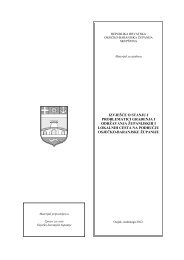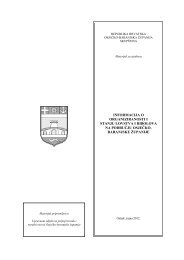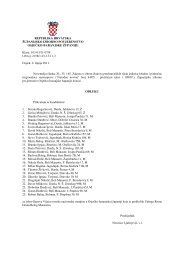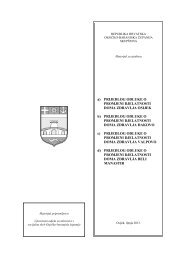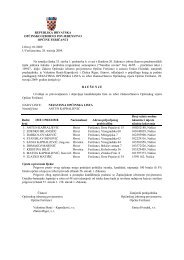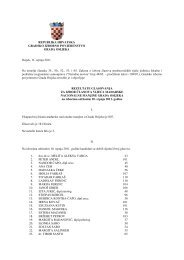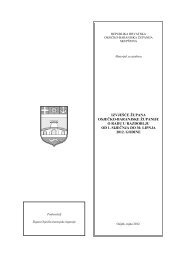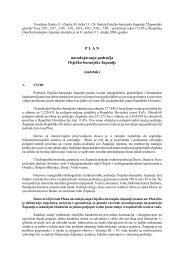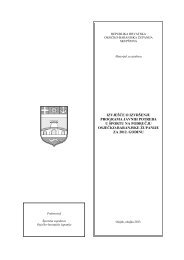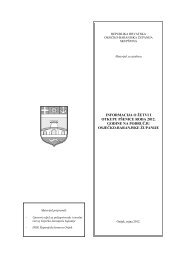Cultural and Historical Heritage of Osijek-Baranja County
Cultural and Historical Heritage of Osijek-Baranja County
Cultural and Historical Heritage of Osijek-Baranja County
Create successful ePaper yourself
Turn your PDF publications into a flip-book with our unique Google optimized e-Paper software.
<strong>Osijek</strong> – <strong>Baranja</strong> <strong>County</strong>
<strong>Cultural</strong> <strong>and</strong> <strong>Historical</strong> <strong>Heritage</strong><strong>of</strong> <strong>Osijek</strong> – <strong>Baranja</strong> <strong>County</strong>A brief overview <strong>of</strong> secular <strong>and</strong> sacral witnesses to history<strong>Osijek</strong> – <strong>Baranja</strong> <strong>County</strong>,a primarily low-lying region<strong>of</strong> the North-East <strong>of</strong>Croatia, stretches along the southborder <strong>of</strong> the Pannonian Plain. Itis a region interwoven with geographicalentities such as <strong>Baranja</strong>region <strong>and</strong> the regions encirclingtowns such as Đakovo, Valpovo<strong>and</strong> Donji Miholjac. The towns <strong>of</strong><strong>Osijek</strong>, Našice, Đakovo, Beli Manastir,Donji Miholjac, Valpovo <strong>and</strong>the villages <strong>of</strong> Aljmaš, Erdut, Bizovac,Bilje, Darda, Kneževo, Batina,Topolje, etc. were founded in thedistant past. The legacy <strong>of</strong> theirrich history is a number <strong>of</strong> culturalmonuments containing pearls <strong>of</strong>the European treasure-trove. 1It is here that the rivers Drava,Karašica, Jošava, Vuka <strong>and</strong> theDanube created fertile soil for humanlife on which the Celts <strong>and</strong>later the Romans moved, leavinga powerful mark in the history<strong>of</strong> huge European regions <strong>and</strong>beyond. It is where the paths <strong>of</strong>exchange between the Thracians<strong>and</strong> Etruscans most likely led <strong>and</strong>it was across these rivers, alongthe marshl<strong>and</strong>s <strong>and</strong> through Pannonianforests that many othernations were travelling from theNorth to the South <strong>and</strong> back. Notwithout reason, though; it is wherethe Danube Limes were situ-1The seat <strong>of</strong> the county is in <strong>Osijek</strong>.Bizovac, Valpovo, Donji Miholjac <strong>and</strong>Našice are located east <strong>of</strong> <strong>Osijek</strong>,Đakovo is located south <strong>of</strong> <strong>Osijek</strong> <strong>and</strong>east <strong>of</strong> the <strong>Osijek</strong>-<strong>Baranja</strong> county arethe villages Aljmaš <strong>and</strong> Erdut; Bilje issituated north <strong>of</strong> <strong>Osijek</strong> as well as thefamous Nature Park Kopački Rit, Darda,Tikveš, Beli Manastir, Kneževo <strong>and</strong>Gajić/Topolje<strong>Cultural</strong> <strong>and</strong> <strong>Historical</strong> <strong>Heritage</strong> <strong>of</strong> <strong>Osijek</strong> - <strong>Baranja</strong> <strong>County</strong> 1
<strong>and</strong> Bishop’s Palace are a reflection<strong>of</strong> the life <strong>of</strong> the Church in theregion. <strong>Cultural</strong> heritage <strong>of</strong> manytowns consists <strong>of</strong> many neo-classical<strong>and</strong> secession monumentsside by side with modern architecture.Each town <strong>and</strong> village in the <strong>Osijek</strong>– <strong>Baranja</strong> <strong>County</strong> has its ownpersonality inherited with a particularhistorical era. A treasuretrovefilled to its brim with cultural<strong>and</strong> historical values so becomesa part <strong>of</strong> everyone’s memory.<strong>Osijek</strong> – Tvrđa, Holy Trinity Squareated <strong>and</strong> where the Drava Riverflowed. Many towns <strong>and</strong> villages<strong>of</strong> the region witnessed to thesubsequent historical events.Baroque buildings in Tvrđa bearwitness to the intersection <strong>of</strong> lives<strong>of</strong> large military garrisons, statecivil service, commercial <strong>and</strong> artisans’class; many luxurious castlesin Valpovo, Bilje, Kneževo, DonjiMiholjac, Našice are testimony tothe practice <strong>of</strong> aristocratic familieswho took care <strong>of</strong> the l<strong>and</strong> <strong>and</strong>the emergence <strong>of</strong> new economicpractice; the Đakovo cathedralBishop Josip JurajStrossmayer2Našice – CastleĐakovo – Bishop’s Palace <strong>and</strong>Cathedral<strong>Cultural</strong> <strong>and</strong> <strong>Historical</strong> <strong>Heritage</strong> <strong>of</strong> <strong>Osijek</strong> - <strong>Baranja</strong> <strong>County</strong>
<strong>Osijek</strong>long <strong>and</strong> turbulent history leftA many cultural <strong>and</strong> historicalmonuments in <strong>Osijek</strong>, especiallythose dating from the 18 th <strong>and</strong>19 th century.Although only partly preserved,Tvrđa (the Citadel), a symmetricalconstruction built in the style<strong>of</strong> baroque, is one <strong>of</strong> the mostimportant ancient town cores <strong>and</strong>urban entities in Croatia <strong>and</strong> beyond.Monuments <strong>of</strong> the baroque Tvrđaare grouped around the mainsquare built in the quadrangularA view <strong>of</strong> Tvrđa from King Tomislav GardensPlague StatueSeveral details<strong>of</strong> the HolyTrinity votivemonumenttian, St. Rok, St. Rozalija <strong>and</strong> St.Catherine). It is one <strong>of</strong> the mostappealing baroque buildings in<strong>Osijek</strong>.The building in which the Museum<strong>of</strong> Slavonia is situated todaywas built in 1702 in the baroquestyle for the former town magistrate.Opposite <strong>of</strong> it is the townguard building dating back to1709, facing the central squareshape <strong>and</strong> dominated by a magnificentbaroque Plague Statue– the Holy Trinity Column – erectedin 1730. A large capital <strong>of</strong> theslender column represents theHoly Trinity with angels on clouds.Below is a pedestal with voluteson which protectors against theplague are situated. Four separatepedestals were added to thePlague Statue in 1784 with thestatues <strong>of</strong> four saints (St. Sebas-Tvrđa – Holy Trinity Square<strong>Cultural</strong> <strong>and</strong> <strong>Historical</strong> <strong>Heritage</strong> <strong>of</strong> <strong>Osijek</strong> - <strong>Baranja</strong> <strong>County</strong> 3
Holy Trinity Square– a view <strong>of</strong> the TownGuard buildingThe Water Gatesome aristocratic families, a line <strong>of</strong>army barracks with open rows <strong>of</strong>arcades, etc.The old Franciscan monastery(with two wings – the eastern<strong>and</strong> southern – in a shape <strong>of</strong>the letter L) must be mentionedamong sacral cultural monumentsin Tvrđa. Its construction startedin 1699 <strong>and</strong> it was completed in1705. In the period from 1731 to1733 a new wing <strong>of</strong> the monas<strong>of</strong>Tvrđa with a range <strong>of</strong> arcades<strong>and</strong> its recognizable tower. At thenorthern side one can see thegeneral headquarters (today’sAdministration Building <strong>of</strong> theJosip Juraj Strossmayer University<strong>and</strong> the Faculty <strong>of</strong> Agriculture),a building <strong>of</strong> huge dimensionswith atlantes on the tall portal.There are dozens <strong>of</strong> other secularmonuments in Tvrđa <strong>and</strong> themost important are the houses <strong>of</strong>Tall portal <strong>of</strong> theGeneral Headquarterswithatlantes (today’sAdministrationBuilding <strong>of</strong>the Josip JurajStrossmayerUniversity <strong>and</strong>the Faculty <strong>of</strong>Agriculture)4<strong>Cultural</strong> <strong>and</strong> <strong>Historical</strong> <strong>Heritage</strong> <strong>of</strong> <strong>Osijek</strong> - <strong>Baranja</strong> <strong>County</strong>
The Museum <strong>of</strong> Slavoniatery was added east <strong>of</strong> the church,which actually became a new monasterycompleted in 1761 <strong>and</strong> connectedto the eastern wing <strong>of</strong> theold monastery building by vaultedarches.In the period from 1709 to 1732the Franciscans built the baroquechurch <strong>of</strong> the Holy Cross, nicknamedthe church <strong>of</strong> St. Anthonyby the citizens <strong>of</strong> <strong>Osijek</strong>. The altaris situated in the east, the entrancein the west <strong>and</strong> its back part in thesouth. During construction it connectedthe corridor <strong>and</strong> organ l<strong>of</strong>twith the monastery; the main altar<strong>of</strong> the Holy Cross (built in 1726)was moved away from the wall <strong>and</strong>the statue <strong>of</strong> Our Lady <strong>of</strong> Jud fromthe 15 th century was erected on it.Many valuable altar paintings <strong>and</strong>other pieces <strong>of</strong> church furniture arekept in the church.Parish Church <strong>of</strong> St. Michael theArchangel, the patron <strong>of</strong> the church,was situated in the west corner <strong>of</strong>the Juraj Križanić Square. This colossalbuilding with a hall <strong>and</strong> twomassive bell towers at the easternfront part is a representative example<strong>of</strong> the Austrian sacral baroquearchitecture in Slavonia. Thanks toits magnitude <strong>and</strong> highly valuablebaroque objects, this longitudinalsingle-nave building with two sidechapels on each side <strong>of</strong> the nave<strong>and</strong> a rounded sanctuary, dominatesnot only the main square butalso the whole area <strong>of</strong> Tvrđa. Builtin the style <strong>of</strong> late baroque characteristic<strong>of</strong> continental Croatia, missingonly paintings on the interiorwalls, this church belongs to one <strong>of</strong>the most important sacral buildingsin the Đakovo-Sirmium Diocese.The Upper Town, built consistently<strong>and</strong> systematically in terms<strong>of</strong> the town planning, is a genuineVaulted archeshistorical treasure trove. Graduallyacquiring all attributes <strong>of</strong> thetown centre, in the second half <strong>of</strong>the 19 th century the Upper Townbecame a representative part <strong>of</strong>the town. This statement is supportedby its many squares <strong>and</strong>the position <strong>and</strong> appearance <strong>of</strong> itsstreets. In addition, many buildingsbuilt in the style <strong>of</strong> historicism <strong>and</strong>secession (Jugendstil) still attractattention.One <strong>of</strong> the oldest sacral cultural<strong>and</strong> historical monuments is theCapuchin monastery built in 1710<strong>and</strong> today’s baroque church <strong>of</strong> St.Jacob, dating back to 1727. It hasa simple facade without any ornaments.The interior <strong>of</strong> the churchwas decorated with representativeoil paintings in the second half <strong>of</strong>the 18 th <strong>and</strong> during the 19 th century.The monumental altar pallabuilt in the late baroque style <strong>of</strong>the Vienna Art Academy, showingthe patron <strong>of</strong> the church, ApostleSt. Jacob Senior in the battle withthe Moors, is immensely valuable.The centre <strong>of</strong> the Upper Town isdominated by the Parish Church<strong>Cultural</strong> <strong>and</strong> <strong>Historical</strong> <strong>Heritage</strong> <strong>of</strong> <strong>Osijek</strong> - <strong>Baranja</strong> <strong>County</strong> 5
Our Lady <strong>of</strong> <strong>Osijek</strong> –Patron <strong>of</strong> the cityFranciscan Monastery <strong>and</strong> theChurch <strong>of</strong> the Holy CrossCloister <strong>of</strong> the FranciscanmonasteryThe CapuchinMonastery <strong>and</strong> St.Jacob’s ChurchThe Church <strong>of</strong> theHoly CrossParish Church <strong>of</strong>St. Michael theArchangel6Interior <strong>of</strong> the Parish Church <strong>of</strong>St. Michael the Archangel<strong>Cultural</strong> <strong>and</strong> <strong>Historical</strong> <strong>Heritage</strong> <strong>of</strong> <strong>Osijek</strong> - <strong>Baranja</strong> <strong>County</strong>
Main altar <strong>of</strong> St. Peter <strong>and</strong> Paul<strong>of</strong> St. Peter <strong>and</strong> Paul, with a brickfacade. Its construction from 1894to 1898 was supported by the thenBosnia-Đakovo-Sirmium bishopJosip Juraj Strossmayer. Its belltower,conspicuous from all sides,is 90 meters tall. The interior <strong>of</strong> thechurch is divided into four galleries.Especially valuable among churchtreasures are frescos made by MirkoRački. The parish church <strong>of</strong> St. Peter<strong>and</strong> Paul gave the central square(Ante Starčević Square) <strong>and</strong> <strong>Osijek</strong>as a whole its recognizable symbol– the town vertical <strong>and</strong> crown.Among many buildings belongingto secular architecture in theUpper Town, especially prominentare the palace in which the seat <strong>of</strong>the then Virovitica county was situated,built in 1864 in the manner <strong>of</strong>classicism <strong>and</strong> which is used todayas the seat <strong>of</strong> the <strong>Osijek</strong>-<strong>Baranja</strong><strong>County</strong> Government; the building <strong>of</strong>the Croatian National Theatre builtin 1866 in “pseudo-Moorish style”<strong>and</strong> the building <strong>of</strong> the CroatianChamber <strong>of</strong> Commerce, situated inthe European Avenue. The Avenueboasts a whole array <strong>of</strong> public <strong>and</strong>privately owned buildings built inthe period from 1904 to 1905,Parish Church <strong>of</strong> St. Peter <strong>and</strong> PaulFrescos <strong>and</strong> stained-glass windows<strong>Cultural</strong> <strong>and</strong> <strong>Historical</strong> <strong>Heritage</strong> <strong>of</strong> <strong>Osijek</strong> - <strong>Baranja</strong> <strong>County</strong> 7
Palace – the seat <strong>of</strong> the<strong>County</strong> GovernmentSecession buildings inEuropean Avenue;several details8<strong>Cultural</strong> <strong>and</strong> <strong>Historical</strong> <strong>Heritage</strong> <strong>of</strong> <strong>Osijek</strong> - <strong>Baranja</strong> <strong>County</strong>
Main Post Office buildingUrania CinemaParish church <strong>of</strong> the MostSacred Name <strong>of</strong> MaryChapel <strong>of</strong> St. Rok <strong>and</strong> statue<strong>of</strong> Marywhich make up the most beautifulrow <strong>of</strong> secession buildings inCroatia. Among them are the mainpost <strong>of</strong>fice building <strong>and</strong> the UraniaCinema built in 1912.The Lower Town <strong>of</strong> <strong>Osijek</strong>, builtupon old foundations <strong>of</strong> the antiquetown <strong>of</strong> Mursa, is mainlygrouped around the main square.There are many valuable sacral<strong>and</strong> secular cultural <strong>and</strong> historicalmonuments. Among themis a baroque chapel <strong>of</strong> St. Rok<strong>Cultural</strong> <strong>and</strong> <strong>Historical</strong> <strong>Heritage</strong> <strong>of</strong> <strong>Osijek</strong> - <strong>Baranja</strong> <strong>County</strong> 9
Former Jewish synagogue – todaya part <strong>of</strong> the Evangelical <strong>and</strong>Theological Faculty <strong>of</strong> <strong>Osijek</strong>1796 – 1801 in the late baroqueclassicism, which was characteristic<strong>of</strong> the west <strong>and</strong> middle Europeancastle architecture <strong>of</strong> that time.It belongs to the Legion <strong>of</strong> MaryMiraculous Medal today. West<strong>of</strong> the former gardens, there is achapel-mausoleum built in a pavilion-stylededicated to the Pejačevićfamily. Today it is a constituent part<strong>of</strong> the Retfala cemetery.10built in 1744 during the greatplague epidemic <strong>and</strong> the statue<strong>of</strong> Mary erected in 1754. Theparish church <strong>of</strong> the Most SacredName <strong>of</strong> Mary, the most beautifulbaroque church, was built inthe period from 1733 to 1743.The former Jewish synagogue inCvjetkova street, built in 1902, is apart <strong>of</strong> the Evangelical <strong>and</strong> TheologicalFaculty <strong>of</strong> <strong>Osijek</strong>. There arealso many family houses built inthe late baroque style in the secondhalf <strong>of</strong> the 18 th century, suchas the houses <strong>of</strong> the Aksmanović,Kragujević <strong>and</strong> other families.In the most western part <strong>of</strong> <strong>Osijek</strong>,also known as Retfala, a singlestoreycastle <strong>of</strong> the count familyPejačević was built during the socalled Napoleonic period fromChapel-mausoleum<strong>of</strong> thePejačević family<strong>Cultural</strong> <strong>and</strong> <strong>Historical</strong> <strong>Heritage</strong> <strong>of</strong> <strong>Osijek</strong> - <strong>Baranja</strong> <strong>County</strong>
BizovacBizovac is a charming Slavonianplace, situated some twentykilometres west <strong>of</strong> <strong>Osijek</strong>. Today it iswell-known for its thermal spa water(<strong>and</strong> indoor <strong>and</strong> outdoor swimmingpools) rather than its single-storeymanor <strong>and</strong> the whole range <strong>of</strong> outbuildingsowned by the counts <strong>of</strong>Pr<strong>and</strong>au - Normann Ehrenfels, builtin the first half <strong>of</strong> the 19 th century.The single-storey castle is built inthe style <strong>of</strong> historicism, shaped asa shallow letter “U” <strong>and</strong> furnishedwith idyllic windows trimmed withornamented wooden frames.Parish church <strong>of</strong> St. Matthew wasbuilt in 1802. It was extended <strong>and</strong>Manor <strong>of</strong> the Pr<strong>and</strong>au – Normann familyMain altara sacristy was added in 1875. Itis a simple classicistic single-navebuilding with a rounded sanctuary.A single-storey parish house wasbuilt in the second half <strong>of</strong> the 19 thcentury.Parish church <strong>of</strong> St. Matthew<strong>Cultural</strong> <strong>and</strong> <strong>Historical</strong> <strong>Heritage</strong> <strong>of</strong> <strong>Osijek</strong> - <strong>Baranja</strong> <strong>County</strong> 11
Donji MiholjacDonji Miholjac, a town situatedalmost at the very bank <strong>of</strong> theriver Drava, has been continuallypopulated from times immemorial.There are two castles in the townin which aristocratic families lived.A fairly large building, also knownas the old castle <strong>of</strong> Miholjac, with afront facade stretching through thevery centre <strong>of</strong> Donji Miholjac, wasbuilt in 1818 by the baroness MarijaAna (née Pejačević), the widow<strong>of</strong> baron Josip Ignac Hillepr<strong>and</strong> vonPr<strong>and</strong>au. The single-storey castlebuilt in the style <strong>of</strong> late baroqueends in a circular decorative turretin its south-eastern corner, movedaway from it <strong>and</strong> connected with itby a terrace. The facade facing thestreet was given certain regularityby a row <strong>of</strong> 19 identical windowsLate baroque one-storey castle <strong>of</strong> the Pr<strong>and</strong>au familywith subtle late baroque ornaments<strong>and</strong> the facade facing thebackyard <strong>of</strong>fers the same impressionby a row <strong>of</strong> bolted windows.The second castle in Miholjac,more recently built <strong>and</strong> as prettyas the first one, is that <strong>of</strong> theCastle <strong>of</strong> the Mailáth family built in the style <strong>of</strong> romanticism <strong>and</strong> historicismMailáth family, built in the style <strong>of</strong>historicism <strong>and</strong> neo-romanticism,with magnificent gardens modelledafter the English gardens,creating thus a picture <strong>of</strong> a castleas if built in the tenor <strong>of</strong> the Tudortimes. It was constructed in theperiod from 1903 to 1906 <strong>and</strong>belongs to one <strong>of</strong> the youngest,prettiest <strong>and</strong> the most romanticcastles <strong>of</strong> Slavonia. A number <strong>of</strong>towers <strong>and</strong> chimneys, semicircular<strong>and</strong> other types <strong>of</strong> risalites, aterrace trimmed by iron pillar-likefences, turrets at the corners, etc.give this castle a particular romantictouch rarely seen in the Slavonianplains. (The Mailáth familyacquired Donji Miholjac throughmarriage with the Pr<strong>and</strong>au family.)The new baroque parish church<strong>of</strong> St. Michael the Archangel, builton ancient Gothic foundations, is acolossal structure <strong>of</strong> the 18 th centurybaroque architecture suggestingsome elements <strong>of</strong> classicism;it is a single-nave church with adistinctive barrel-shaped archedceiling <strong>and</strong> a rounded sanctuary.<strong>Cultural</strong> <strong>and</strong> <strong>Historical</strong> <strong>Heritage</strong> <strong>of</strong> <strong>Osijek</strong> - <strong>Baranja</strong> <strong>County</strong> 13
NašiceNašice is famous for its cultural<strong>and</strong> historical monuments aswell as their remains dating back tothe medieval times. It was the Franciscanswho left a particularly importantmark by building a colossalthree-winged single-storey monasteryin the 18 th century, which wasre-constructed in the period from1712 to 1755. They also turnedrenovated after the earthquake in1817. It was exp<strong>and</strong>ed during thecount Ladislav Pejačević’s life <strong>and</strong>took on its present appearance forthe most part in 1850. In 1865 thecastle was exp<strong>and</strong>ed considerably<strong>and</strong> rounded towers were added atthe edges <strong>of</strong> the castle. (The castleis a home <strong>of</strong> the <strong>County</strong> Museum<strong>and</strong> art gallery today). Pejačević’sFranciscan monastery with the Church <strong>of</strong>St. Anthony <strong>of</strong> Padua14the old gothic church <strong>of</strong> St. Anthony<strong>of</strong> Padua into a baroque church.There are medieval altars in thechurch (built 1765 – 1774), a pulpit(1769), confessionals (1772),an organ made by Josip Janeček<strong>of</strong> Budim (1776), a rococo oratorywith the Pejačević family coat<strong>of</strong> arms, choir l<strong>of</strong>t pews <strong>and</strong> otherchurch furnishings.The most impressive buildings inthe centre <strong>of</strong> Našice are two castles<strong>of</strong> the count Pejačević family, situatedin spacious English gardens.They are beautiful examples <strong>of</strong> thecountry-style architecture in easternCroatia built in the manner <strong>of</strong> historicism<strong>and</strong> classicism. The main,great castle <strong>of</strong> the Pejačević familywas built in 1812 <strong>and</strong> completelyGreat castle <strong>of</strong> the Pejačevićfamily with gardensHunting castle or small castle <strong>of</strong>the Pejačević familyhunting house , also known as thesmall castle is situated in the centre<strong>of</strong> the gardens (it is today used asa school). It was built in the style <strong>of</strong>classicism in 1905 <strong>and</strong> was movedinto two years later.There are several buildings built inthe style <strong>of</strong> classicism <strong>and</strong> secessionin the centre <strong>of</strong> Našice <strong>and</strong> anumber <strong>of</strong> tombs at the local cemetery– neo-gothic mausoleum chapelwith the crypt <strong>of</strong> the Pejačevićfamily <strong>and</strong> the grave <strong>of</strong> the famousCroatian composer Dora Pejačevićwith her marble bust.<strong>Cultural</strong> <strong>and</strong> <strong>Historical</strong> <strong>Heritage</strong> <strong>of</strong> <strong>Osijek</strong> - <strong>Baranja</strong> <strong>County</strong>
ĐakovoĐakovo has every right to beproud <strong>of</strong> its past as well asmany cultural <strong>and</strong> historical monumentsdating from times immemorial<strong>and</strong> more recent ones from the20 th century. Known as Certissa inthe Roman times or castrum Dyacoin the Middle Ages it was mentionedfor the first time in 1239 induke Koloman’s deed <strong>of</strong> donation.He was the brother <strong>of</strong> theCroatian-Hungarian king Bela IV,Parish Church <strong>of</strong> All SaintsLate baroque capitularycanonicalresidencesseum, a memorial to the bishopJosip Juraj Strossmayer <strong>and</strong> themuseum <strong>of</strong> the Đakovo regionwith a picture gallery, the diocesanarchives <strong>and</strong> library, monastery <strong>of</strong>the sisters <strong>of</strong> the Holy Cross witha church <strong>and</strong> some other buildings– have preserved the charm<strong>of</strong> the old town core which is interwovenwith baroque, secession<strong>and</strong> historicism features.who donated the town <strong>of</strong> Đakovowith a large l<strong>and</strong> area to Bosnianbishops. Symmetrically built <strong>and</strong>in terms <strong>of</strong> style uniform buildings,the parts <strong>of</strong> which originate fromvarious historical periods – thewalls from the 14 th century, theparish church <strong>of</strong> All Saints – theformer Turkish mosque from the16 th century, late baroque capitularycanonical residences, neoromanicbishop’s cathedral <strong>of</strong> St.Peter, Chancery, the diocesan mu-Memorial to Bishop Josip Juraj Strossmayer<strong>Cultural</strong> <strong>and</strong> <strong>Historical</strong> <strong>Heritage</strong> <strong>of</strong> <strong>Osijek</strong> - <strong>Baranja</strong> <strong>County</strong> 15
The panorama <strong>of</strong> Đakovo isdominated by a monumentalneoromanic cathedral <strong>of</strong> St. Peterwith two bell towers (84 metrestall), erected by the Bosnia-Đakovo-Sirmium bishop Josip JurajStrossmayer. It was constructedin the period from 1866 to1882 according to the designmade by two Vienna architects,Karl Roesner <strong>and</strong> Friedrich vonSchmidt. There is a crypt in thecathedral, the final resting place<strong>of</strong> bishop Josip Juraj Strossmayer,which is ornamented with afamous relief, a work <strong>of</strong> RudolfValdec.St. Peter’s CathedralInterior <strong>of</strong> theCathedral16<strong>Cultural</strong> <strong>and</strong> <strong>Historical</strong> <strong>Heritage</strong> <strong>of</strong> <strong>Osijek</strong> - <strong>Baranja</strong> <strong>County</strong>
AljmašIn Aljmaš, a village situated inthe vicinity <strong>of</strong> confluence <strong>of</strong> therivers Drava <strong>and</strong> the Danube,witnesses to history - castle <strong>and</strong>manor <strong>of</strong> the aristocratic familyAdamović - are situated at a hillyside <strong>of</strong> the village. A spacious castlein the style <strong>of</strong> classicism wasbuilt at the beginning <strong>of</strong> the 19 thcentury. It is a single-storey buildingbuilt in the shape <strong>of</strong> the letter“U” with a very pronounced <strong>and</strong>long portico at the entrance. Theportico is supported by four massiverectangular columns <strong>and</strong> tworounded columns in the middlewith a flight <strong>of</strong> five steps in between.This magnificent entranceportico ends with a large triangulargable decorated with a motif<strong>of</strong> blind arcades at the edges.The manor <strong>of</strong> the Adamović familywas also built in the first half<strong>of</strong> the 19 th century. It is a simpleclassicistic one-storey building laidout in the rectangular shape. Itsfront is composed by nine windowaxes, two <strong>of</strong> which are shallowrisalite projections. (Both buildingswere severely damaged in 1991.)Votive statue <strong>of</strong> Our Lady <strong>of</strong> ConsolationAljmaš is a diocesan parish <strong>and</strong>one <strong>of</strong> the most important parishfºte sites honouring the BlessedVirgin Mary in the eastern Croatia.The parish church <strong>of</strong> the Visitation<strong>of</strong> Mary contains a sanctuary witha statue <strong>of</strong> Our Lady <strong>of</strong> Consolation,brought there in 1704 bythe Jesuits <strong>of</strong> <strong>Osijek</strong>. During histhird papal visit to Croatia on June7, 2003 His Holiness Pope JohnPaul II, crowned the votive statue<strong>of</strong> Our Lady <strong>of</strong> Consolation in aspecial ceremony at the Eucharistin <strong>Osijek</strong>.<strong>Cultural</strong> <strong>and</strong> <strong>Historical</strong> <strong>Heritage</strong> <strong>of</strong> <strong>Osijek</strong> - <strong>Baranja</strong> <strong>County</strong> 17
ErdutLike guards at the Danube nextto the village <strong>of</strong> Erdut st<strong>and</strong> theruins <strong>of</strong> a former medieval fortifiedfeudal town <strong>and</strong> later a seat<strong>of</strong> manorial estate. The place itselfrises some hundred meters abovethe right bank <strong>of</strong> the Danube justin the centre <strong>of</strong> a me<strong>and</strong>er createdby the Danube between thevillages <strong>of</strong> Aljmaš <strong>and</strong> Dalj.The Adamović-Cseh family built alargish manor which served as acentre <strong>of</strong> the estate <strong>and</strong> residentialarea <strong>and</strong> owned many outhouses<strong>and</strong> large cellars which are usedeven today. The layout <strong>of</strong> themanor, built at the end <strong>of</strong> the 18 thor beginning <strong>of</strong> the 19 th centuryin the style <strong>of</strong> historicism, is quiteextended. It is a building with asingle-storey wing <strong>and</strong> polygonaltower with a turret. (It is a placewhere on November 12, 1995the Erdut Agreement was signed,a document marking the end <strong>of</strong>the Croatian War <strong>of</strong> Independence<strong>and</strong> founding <strong>of</strong> the UnitedNations Transitional Administrationin Eastern Slavonia, <strong>Baranja</strong> <strong>and</strong>Western Sirmium (UNTAES).Manor <strong>of</strong> theAdamović-Csehfamily18<strong>Cultural</strong> <strong>and</strong> <strong>Historical</strong> <strong>Heritage</strong> <strong>of</strong> <strong>Osijek</strong> - <strong>Baranja</strong> <strong>County</strong>
BiljeCastle <strong>of</strong> Eugene <strong>of</strong> SavoyBilje, a village in <strong>Baranja</strong> situatednext to one <strong>of</strong> the largestEuropean marshl<strong>and</strong> <strong>and</strong> birdreservesbordering the Danube,Kopački Rit, boasts a magnificentbaroque castle with large gardens,built by Prince Eugene <strong>of</strong> Savoy inthe period from 1705 to 1712.The main <strong>and</strong> most representativepart <strong>of</strong> the castle is a single-storeyconstruction with a massive towerin the central part, ornamentedby pilasters <strong>and</strong> pr<strong>of</strong>iled sculpturalwreaths. Side wings are designedin a simple manner with regularrows <strong>of</strong> windows. At the front facadeabove the entrance passagewaythere is a well-preserved polychromecoat <strong>of</strong> arms <strong>of</strong> the Savoyfamily. The trench around thecastle reminds <strong>of</strong> a medieval type<strong>of</strong> defence. The central buildingfaces the bridge. The castle usedto be a seat <strong>of</strong> the huge Belje manorialestate until 1827 when themanagement moved to Kneževo.The whole complex <strong>of</strong> the castleis supplemented by romantic, spacious<strong>and</strong> tended gardens.A detail – Coat <strong>of</strong> arms <strong>of</strong> theSavoy familyThe parish church <strong>of</strong> ImmaculateConception <strong>of</strong> the Blessed VirginMary was built in 1775. It used tobe a sacral single-nave constructionwith rounded sanctuary <strong>and</strong>furnishings characteristic <strong>of</strong> latebaroque <strong>and</strong> early classicism style.(During the aggression againstCroatia in 1991/1992 the belltower was destroyed, the sacristyburnt down <strong>and</strong> all treasures pillaged).After the peaceful reintegration<strong>of</strong> <strong>Baranja</strong> in 1998 thechurch was completely reconstructed<strong>and</strong> its former splendourwas thus restored.<strong>Cultural</strong> <strong>and</strong> <strong>Historical</strong> <strong>Heritage</strong> <strong>of</strong> <strong>Osijek</strong> - <strong>Baranja</strong> <strong>County</strong> 19
DardaThe castle complex <strong>and</strong> gardens<strong>of</strong> the Croatian-Hungarianfamily Eszterházy can be reachedthrough a secession iron gatemade by h<strong>and</strong> by an unknownartist. Although the castle in Dardais the so called ‘second category’monument, it is in a very poorcondition due to complete devastation<strong>and</strong> plundering during theCroatian War <strong>of</strong> Independence(1991/1992). It is still awaitingreconstruction. It is a single-storeybuilding erected in the secondhalf <strong>of</strong> the 18 th century as acentral part <strong>of</strong> the spacious estateowned by baron Eszterházy. It is acombination <strong>of</strong> a baroque layoutcharacteristic <strong>of</strong> the time in whichit was built <strong>and</strong> the concept <strong>of</strong>classicism which was just startingto develop in architecture. In thecentral part <strong>of</strong> the front, on threeidentical arcades, lies a woodenver<strong>and</strong>a fitted with glass <strong>and</strong> endingin a triangular classicistic gable.Side wings have simple lines <strong>and</strong>are connected with single-storeyouthouses in the backyard.There is a parish church <strong>of</strong> St.John the Baptist in the vicinity <strong>of</strong>the castle, which was built in theperiod from 1715 – 1717. Thissplendid baroque constructionused to be a single-nave churchwith a risalite bell tower abovethe main entrance until it wascompletely destroyed during theCroatian War <strong>of</strong> Independence.The church had valuable interiortreasures dating from the 18 th <strong>and</strong>19 th century. (It has yet to be reconstructed).There is also a parochial church <strong>of</strong>St. Michael in Darda, which wasbuilt in 1777 in the baroque style.It has a barrel-shaped ceiling inthe nave <strong>and</strong> it is furnished by the18 th <strong>and</strong> for the most part the 19 thcentury furniture characteristic <strong>of</strong>classicism.Castle <strong>of</strong> baronEszterházy20<strong>Cultural</strong> <strong>and</strong> <strong>Historical</strong> <strong>Heritage</strong> <strong>of</strong> <strong>Osijek</strong> - <strong>Baranja</strong> <strong>County</strong>
TikvešIn a natural paradise <strong>of</strong> the Danubemarshl<strong>and</strong>s, south <strong>of</strong> the<strong>Baranja</strong> village <strong>of</strong> Lug, a small single-storeyhunting castle was builtin the 19 th century in a famousforest <strong>and</strong> hunting resort <strong>of</strong> Tikveš.The castle was probably built byarch-duke Fridrich von Habsburg.Until the World War I the castlewas used as a summer house <strong>and</strong>a hunting lodge.The main castle in Tikveš wasbuilt in the 1930s in a classicisticstyle with features characteristic <strong>of</strong>secession <strong>and</strong> several outhouseswere added in the mid-twentiethcentury. The front <strong>of</strong> the castledemonstrates the liveliness <strong>of</strong>classicism, enclosed by tuck-pointedfacade bricks <strong>and</strong> corners areplastered in such a way that thefacade resembles stone blocks.(During the Croatian War <strong>of</strong> Independencein 1991/1992 itwas devastated <strong>and</strong> pillaged <strong>and</strong>Great castle in Tikvešremained so all until the peacefulreintegration <strong>of</strong> <strong>Baranja</strong> in1998. Today it is reconstructed<strong>and</strong> turned into tourist facilities. Itis under the administration <strong>of</strong> theNature Park Kopački Rit.)Hunting castle<strong>Cultural</strong> <strong>and</strong> <strong>Historical</strong> <strong>Heritage</strong> <strong>of</strong> <strong>Osijek</strong> - <strong>Baranja</strong> <strong>County</strong> 21
Beli ManastirThere are two sacral buildings inBeli Manastir – parish church<strong>of</strong> St. Martin the Bishop <strong>and</strong> aparochial Orthodox church <strong>of</strong> St.Michael the Archangel.The wooden parish church <strong>of</strong> St.Martin the Bishop was built in1738 <strong>and</strong> a late baroque churchwas built on its foundations in1777, which was later reconstructedseveral times during the19 th <strong>and</strong> the 20 th century. (Thissacral object was severely damaged<strong>and</strong> destroyed by the fire inthe aggression against Croatia in1991/1992. After the peacefulreintegration <strong>of</strong> <strong>Baranja</strong> in 1998it was completely renovated <strong>and</strong>its former splendour was thus restored.)Parish church <strong>of</strong>St. Martin the BishopA single-nave late baroque parochialOrthodox church <strong>of</strong> St.Michael the Archangel was builtin 1771. Rich church furnishingswere preserved in it.Parochial Orthodox church <strong>of</strong> St.Michael the Archangel22<strong>Cultural</strong> <strong>and</strong> <strong>Historical</strong> <strong>Heritage</strong> <strong>of</strong> <strong>Osijek</strong> - <strong>Baranja</strong> <strong>County</strong>
KneževoThere are several buildings inlate baroque/historicism <strong>and</strong>classicism style in the very centre<strong>of</strong> Kneževo, which were used foreconomic <strong>and</strong> partly managerialpurposes <strong>of</strong> the great Belje manorialestate.The castle in Kneževo was built in1828 (according to some sourcesin 1818) as a single-storey buildingwith unpretentious classicisticfeatures. It did not have any representativepurpose but rather itwas an economic seat <strong>of</strong> manor’sowners. Its layout demonstrates avery elongated rectangular shape.Its western main facade faces thevillage <strong>and</strong> its eastern the gardens.The central, two-storey part <strong>of</strong> thecastle with a triangular gable, atthe length <strong>of</strong> the window axes, risesabove fundamental dimensions<strong>of</strong> the castle, showing ornamentsin the shape <strong>of</strong> shallow risalite onthe main facade. All front facadeshave simple forms, except for themain front facade decorated witha portal with a segmented arch,rustic ornaments in the groundfloor,two-storey pilasters in thecentral risalite part <strong>and</strong> a sculpturedwreath dividing the groundfloor<strong>and</strong> the first-floor.Castle in Kneževo<strong>Cultural</strong> <strong>and</strong> <strong>Historical</strong> <strong>Heritage</strong> <strong>of</strong> <strong>Osijek</strong> - <strong>Baranja</strong> <strong>County</strong> 23




